Characteristics and Source Analysis of High-Arsenic Groundwater in Typical Watershed Areas of Tibet, China
Abstract
1. Introduction
2. Background Conditions of the Study Area
2.1. Geographic Conditions
2.2. Geological Conditions
2.3. Hydrogeological Conditions
2.4. Hot Springs
3. Research Methods and Sample Collection
Sampling and Monitoring Plan
4. Results and Discussion
4.1. Arsenic Properties of Groundwater
4.2. Hydrochemical Characteristics and Arsenic Source Indications
4.2.1. Hydrochemical Characteristics Indicating the Origin of Groundwater
4.2.2. Processing-Based Analysis of Hydrochemical Properties
4.2.3. Relationship between Components and Arsenic
4.3. Genesis of the Hot Spring and Recharge–Discharge Mode
4.3.1. Recharge Elevation
4.3.2. Thermal Storage Temperature and Depth
4.3.3. Mixing Ratio of Hot and Cold Water
4.3.4. Origin of Geothermal Water
5. Conclusions
Author Contributions
Funding
Data Availability Statement
Conflicts of Interest
References
- Julia, L.B.; Pamela, A.R. Chapter 4: Arsenic in Groundwater: A Summary of Sources and the Biogeochemical and Hydrogeologic Factors Affecting Arsenic Occurrence and Mobility. In Current Perspectives in Contaminant Hydrology and Water Resources Sustainability; Paul, M.B., Ed.; IntechOpen: Rijeka, Croatia, 2013; pp. 83–116. [Google Scholar]
- Winkel, L.H.E.; Trang, P.T.K.; Lan, V.M.; Stengela, C.; Aminia, M.; Hac, N.T.; Vietb, P.H.; Berg, M. Arsenic pollution of groundwater in Vietnam exacerbated by deep aquifer exploitation for more than a century. Proc. Natl. Acad. Sci. USA 2011, 108, 1246–1251. [Google Scholar] [CrossRef]
- Chakraborti, D.; Singh, S.K.; Rahman, M.M.; Dutta, R.N.; Mukherjee, S.C.; Pati, S.; Kar, P.B. Groundwater Arsenic Contamination in the Ganga River Basin: A Future Health Danger. Int. J. Environ. Res. Public Health 2018, 15, 180. [Google Scholar] [CrossRef]
- Kumar, S.; Pati, J. Assessment of groundwater arsenic contamination using machine learning in Varanasi, Uttar Pradesh, India. J. Water Health 2022, 20, 829–848. [Google Scholar] [CrossRef]
- Thakur, J.K.; Thakur, R.K.; Ramanathan, A.; Kumar, M.; Singh, S.K. Arsenic Contamination of Groundwater in Nepal—An Overview. Water 2011, 3, 1–20. [Google Scholar] [CrossRef]
- Michael, H.A.; Voss, C.I. Evaluation of the sustainability of deep groundwater as an arsenic-safe resource in the Bengal Basin. Proc. Natl. Acad. Sci. USA 2008, 105, 8531–8536. [Google Scholar] [CrossRef]
- Bhattacharyya, R.; Chatterjee, D.; Nath, B.; Jana, J.; Jacks, G.; Vahter, M. High arsenic groundwater: Mobilization, metabolism and mitigation–an overview in the Bengal Delta Plain. Mol. Cell. Biochem. 2003, 253, 347–355. [Google Scholar] [CrossRef]
- Rodríguez-Lado, L.; Sun, G.; Berg, M.; Zhang, Q.; Xue, H.; Zheng, Q.; Johnson, C.A. Groundwater arsenic contamination throughout China. Science 2013, 341, 866–868. [Google Scholar] [CrossRef]
- Wang, Z.; Guo, H.; Xiu, W.; Wang, J.; Shen, M. High arsenic groundwater in the Guide basin, northwestern China: Distribution and genesis mechanisms. Sci. Total Environ. 2018, 640, 194–206. [Google Scholar] [CrossRef] [PubMed]
- Li, L.; Wang, Y.; Gu, H.; Lu, L.; Li, L.; Pang, J.; Chen, F. The Genesis Mechanism and Health Risk Assessment of High Boron Water in The Zhaxikang Geothermal Area, South Tibet. Water 2022, 14, 3243. [Google Scholar] [CrossRef]
- Smedley, P.L.; Kinniburgh, D.G. A review of the source, behaviour and distribution of arsenic in natural waters. Appl. Geochem. 2002, 17, 517–568. [Google Scholar] [CrossRef]
- Shankar, S.; Shanker, U. Arsenic contamination of groundwater: A review of sources, prevalence, health risks, and strategies for mitigation. Sci. World J. 2014, 2014, 304524. [Google Scholar] [CrossRef] [PubMed]
- Litter, M.I.; Ingallinella, A.M.; Olmos, V.; Savio, M.; Difeo, G.; Botto, L.; Ahmad, A. Arsenic in Argentina: Occurrence, human health, legislation and determination. Sci. Total Environ. 2019, 676, 756–766. [Google Scholar] [CrossRef]
- Wei, M.; Wu, J.; Li, W.; Zhang, Q.; Su, F.; Wang, Y. Groundwater Geochemistry and its Impacts on Groundwater Arsenic Enrichment, Variation, and Health Risks in Yongning County, Yinchuan Plain of Northwest China. Expo Health 2022, 14, 219–238. [Google Scholar] [CrossRef]
- Mukherjee, A.; Bhattacharya, P.; Shi, F.; Fryar, A.E.; Mukherjee, A.B.; Xie, Z.M.; Bundschuh, J. Chemical evolution in the high arsenic groundwater of the Huhhot basin (Inner Mongolia, PR China) and its difference from the western Bengal basin (India). Appl. Geochem. 2009, 24, 1835–1851. [Google Scholar] [CrossRef]
- Podgorski, J.; Berg, M. Global threat of arsenic in groundwater. Science 2020, 368, 845–850. [Google Scholar] [CrossRef]
- Guo, H.; Wen, D.; Liu, Z.; Jia, Y.; Guo, Q. A review of high arsenic groundwater in Mainland and Taiwan, China: Distribution, characteristics and geochemical processes. Appl. Geochem. 2014, 41, 196–217. [Google Scholar] [CrossRef]
- Fan, H.; Su, C.; Wang, Y.; Yao, J.; Zhao, K.; Wang, Y.; Wang, G. Sedimentary arsenite-oxidizing and arsenate-reducing bacteria associated with high arsenic groundwater from Shanyin, Northwestern China. J. Appl. Microbiol. 2008, 105, 529–539. [Google Scholar] [CrossRef] [PubMed]
- Deng, Y.; Wang, Y.; Ma, T. Isotope and minor element geochemistry of high arsenic groundwater from Hangjinhouqi, the Hetao Plain, Inner Mongolia. Appl. Geochem. 2009, 24, 587–599. [Google Scholar] [CrossRef]
- Guo, H.; Liu, C.; Lu, H.; Wanty, R.B.; Wang, J.; Zhou, Y. Pathways of coupled arsenic and iron cycling in high arsenic groundwater of the Hetao basin, Inner Mongolia, China: An iron isotope approach. Geochim. Cosmochim. Acta 2013, 112, 130–145. [Google Scholar] [CrossRef]
- He, X.; Li, P.; Ji, Y.; Wang, Y.; Su, Z.; Elumalai, V. Groundwater arsenic and fluoride and associated arsenicosis and fluorosis in China: Occurrence, distribution and management. Expo. Health 2020, 12, 355–368. [Google Scholar] [CrossRef]
- Qiao, W.; Guo, H.; He, C.; Shi, Q.; Zhao, B. Unraveling roles of dissolved organic matter in high arsenic groundwater based on molecular and optical signatures. J. Hazard. Mater. 2021, 406, 124702. [Google Scholar] [CrossRef]
- He, X.; Li, P.; Wu, J.; Wei, M.; Ren, X.; Wang, D. Poor groundwater quality and high potential health risks in the Datong Basin, northern China: Research from published data. Environ. Geochem. Health 2021, 43, 791–812. [Google Scholar] [CrossRef]
- Smith, R.; Knight, R.; Fendorf, S. Over pumping leads to California groundwater arsenic threat. Nat. Commun. 2018, 9, 2089. [Google Scholar] [CrossRef]
- Fang, Y.; Qian, B.; Yang, Y.; Song, Y.; Yang, Z.; Li, H. Purification of high-arsenic groundwater by magnetic bimetallic MOFs coupled with PMS: Balance of catalysis and adsorption and promotion mechanism of PMS. Chem. Eng. J. 2022, 432, 134417. [Google Scholar] [CrossRef]
- Cao, W.; Gao, Z.; Guo, H.; Pan, D.; Qiao, W.; Wang, S.; Li, Z. Increases in groundwater arsenic concentrations and risk under decadal groundwater withdrawal in the lower reaches of the Yellow River basin, Henan Province, China. Environ. Pollut. 2022, 296, 118741. [Google Scholar] [CrossRef] [PubMed]
- Singh, P.; Pal, P.; Mondal, P.; Saravanan, G.; Nagababu, P.; Majumdar, S.; Bhowmick, S. Kinetics and mechanism of arsenic removal using sulfide-modified nanoscale zerovalent iron. Chem. Eng. J. 2021, 412, 128667. [Google Scholar] [CrossRef]
- Luo, Y.; Xiao, Y.; Hao, Q.; Zhang, Y.; Zhao, Z.; Wang, S.; Dong, G. Groundwater geochemical signatures and implication for sustainable development in a typical endorheic watershed on Tibetan plateau. Environ. Sci. Pollut. Res. 2021, 28, 48312–48329. [Google Scholar] [CrossRef]
- Zeng, D.; Chen, G.; Zhou, P.; Xu, H.; Qiong, A.; Duo, B.; Lu, X.; Wang, Z.; Han, Z. Factors influencing groundwater contamination near municipal solid waste landfill sites in the Qinghai-Tibetan plateau. Ecotoxicol. Environ. Saf. 2021, 211, 111913. [Google Scholar] [CrossRef]
- Zhang, J.W.; Yan, Y.N.; Zhao, Z.Q.; Li, X.D.; Guo, J.Y.; Ding, H.; Cui, L.F.; Meng, J.L.; Liu, C.Q. Spatial and seasonal variations of dissolved arsenic in the Yarlung Tsangpo River, southern Tibetan Plateau. Sci. Total Environ. 2021, 760, 143416. [Google Scholar] [CrossRef] [PubMed]
- Zhou, L.; Xu, Z.; Zhou, J.; Fan, P. Natural arsenic source, migration, and flux in a catchment on the Southern Tibetan Plateau. Sci. Total Environ. 2022, 838, 155898. [Google Scholar] [CrossRef]
- Yu, C.; Hua, K.; Huang, C.S.; Jin, H.; Sun, Y.; Yu, Z. Spatiotemporal characteristics of arsenic and lead with seasonal freeze-thaw cycles in the source area of the Yellow River Tibet Plateau, China. J. Hydrol. Reg. Stud. 2022, 44, 101210. [Google Scholar] [CrossRef]
- Yu, C.; Sun, Y.; Zhong, X.; Yu, Z.; Li, X.; Yi, P.; Jin, H.; Luo, D. Arsenic in permafrost-affected rivers and lakes of Tibetan Plateau, China. Environ. Pollut. Bioavailab. 2019, 31, 226–232. [Google Scholar] [CrossRef]
- Zhao, Z.; Li, S.; Xue, L.; Liao, J.; Zhao, J.; Wu, M.; Wang, M.; Sun, J.; Zheng, Y.; Yang, Q. Effects of dam construction on arsenic mobility and transport in two large rivers in Tibet, China. Sci. Total Environ. 2020, 741, 140406. [Google Scholar] [CrossRef] [PubMed]
- Li, S.; Wang, M.; Yang, Q.; Wang, H.; Zhu, J.; Zheng, B.; Zheng, Y. Enrichment of arsenic in surface water, stream sediments and soils in Tibet. J. Geochem. Explor. 2013, 135, 104–116. [Google Scholar] [CrossRef] [PubMed]
- Li, C.; Kang, S.; Chen, P.; Zhang, Q.; Mi, J.; Gao, S.; Sillanpää, M. Geothermal spring causes arsenic contamination in river waters of the southern Tibetan Plateau, China. Environ. Earth Sci. 2014, 71, 4143–4148. [Google Scholar] [CrossRef]
- Mukherjee, A.; Verma, S.; Gupta, S.; Henke, K.R.; Bhattacharya, P. Influence of tectonics, sedimentation and aqueous flow cycles on the origin of global groundwater arsenic: Paradigms from three continents. J. Hydrol. 2014, 518, 284–299. [Google Scholar] [CrossRef]
- He, S.; Li, P. A MATLAB based graphical user interface (GUI) for quickly producing widely used hydrogeochemical diagrams. Geochemistry 2020, 80, 125550. [Google Scholar] [CrossRef]
- Ren, X.; Li, P.; He, X.; Su, F.; Elumalai, V. Hydrogeochemical Processes Affecting Groundwater Chemistry in the Central Part of the Guanzhong Basin, China. Arch. Environ. Contam. Toxicol. 2021, 80, 74–91. [Google Scholar] [CrossRef]
- Duan, R.; Li, P.Y.; Wang, L.; He, X.; Zhang, L. Hydrochemical characteristics, hydrochemical processes and recharge sources of the geothermal systems in Lanzhou City, northwestern China. Urban Clim. 2022, 43, 101152. [Google Scholar] [CrossRef]
- Verma, S.; Mukherjee, A.; Mahanta, C.; Choudhury, R.; Badoni, R.P.; Joshi, G. Arsenic fate in the Brahmaputra river basin aquifers: Controls of geogenic processes, provenance and water-rock interactions. Appl. Geochem. 2019, 107, 171–186. [Google Scholar] [CrossRef]
- Price, R.E.; Pichler, T. Abundance and mineralogical association of arsenic in the Suwannee Limestone (Florida): Implications for arsenic release during water–rock interaction. Chem. Geol. 2006, 228, 44–56. [Google Scholar] [CrossRef]
- Bonte, M.; van Breukelen, B.M.; Stuyfzand, P.J. Temperature-induced impacts on groundwater quality and arsenic mobility in anoxic aquifer sediments used for both drinking water and shallow geothermal energy production. Water Res. 2013, 47, 5088–5100. [Google Scholar] [CrossRef]
- Possemiers, M.; Huysmans, M.; Batelaan, O. Influence of Aquifer Thermal Energy Storage on groundwater quality: A review illustrated by seven case studies from Belgium. J. Hydrol. Reg. Stud. 2014, 2, 20–34. [Google Scholar] [CrossRef]
- Goodsell, T.H.; Carling, G.T.; Aanderud, Z.T.; Nelson, S.T.; Fernandez, D.P.; Tingey, D.G. Thermal groundwater contributions of arsenic and other trace elements to the middle Provo River, Utah, USA. Environ. Earth Sci. 2017, 76, 268. [Google Scholar] [CrossRef]
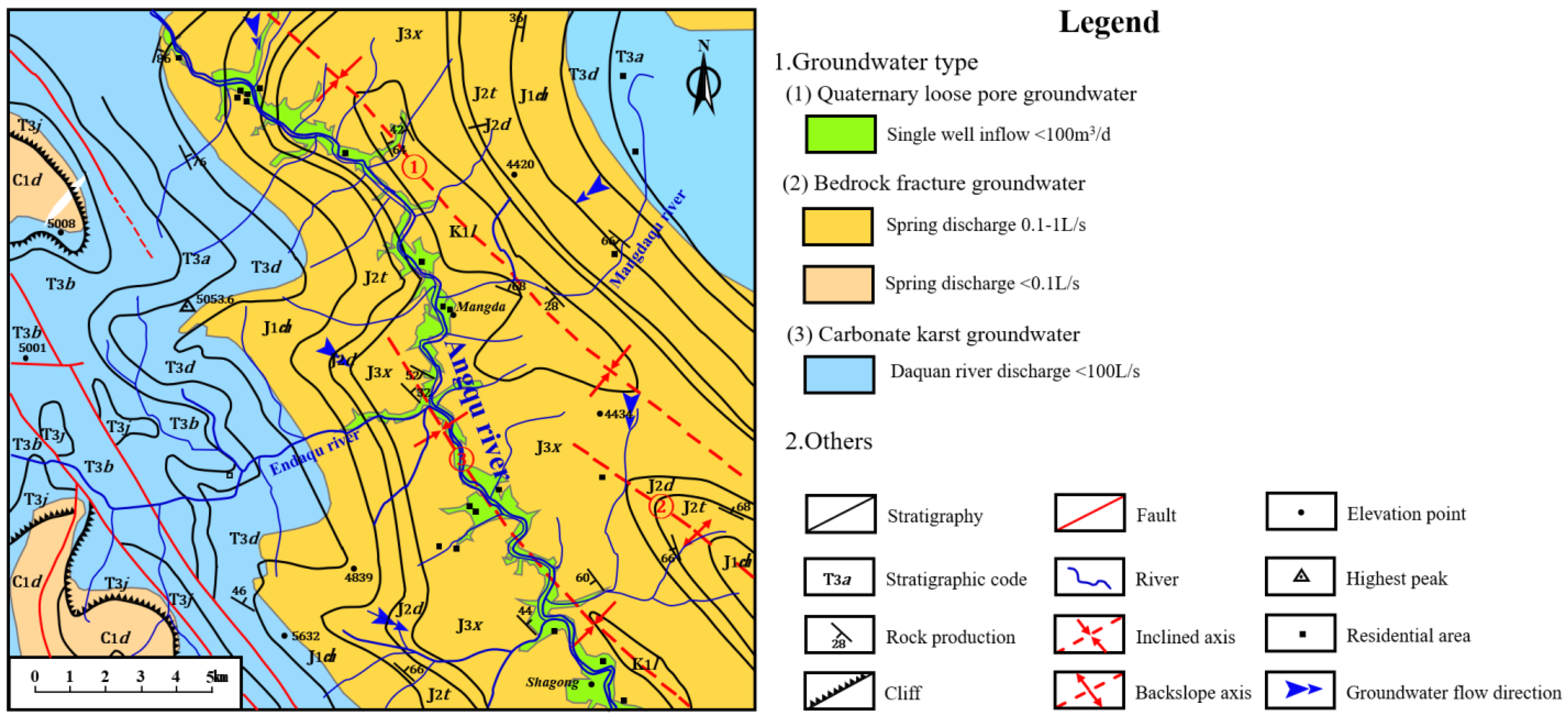

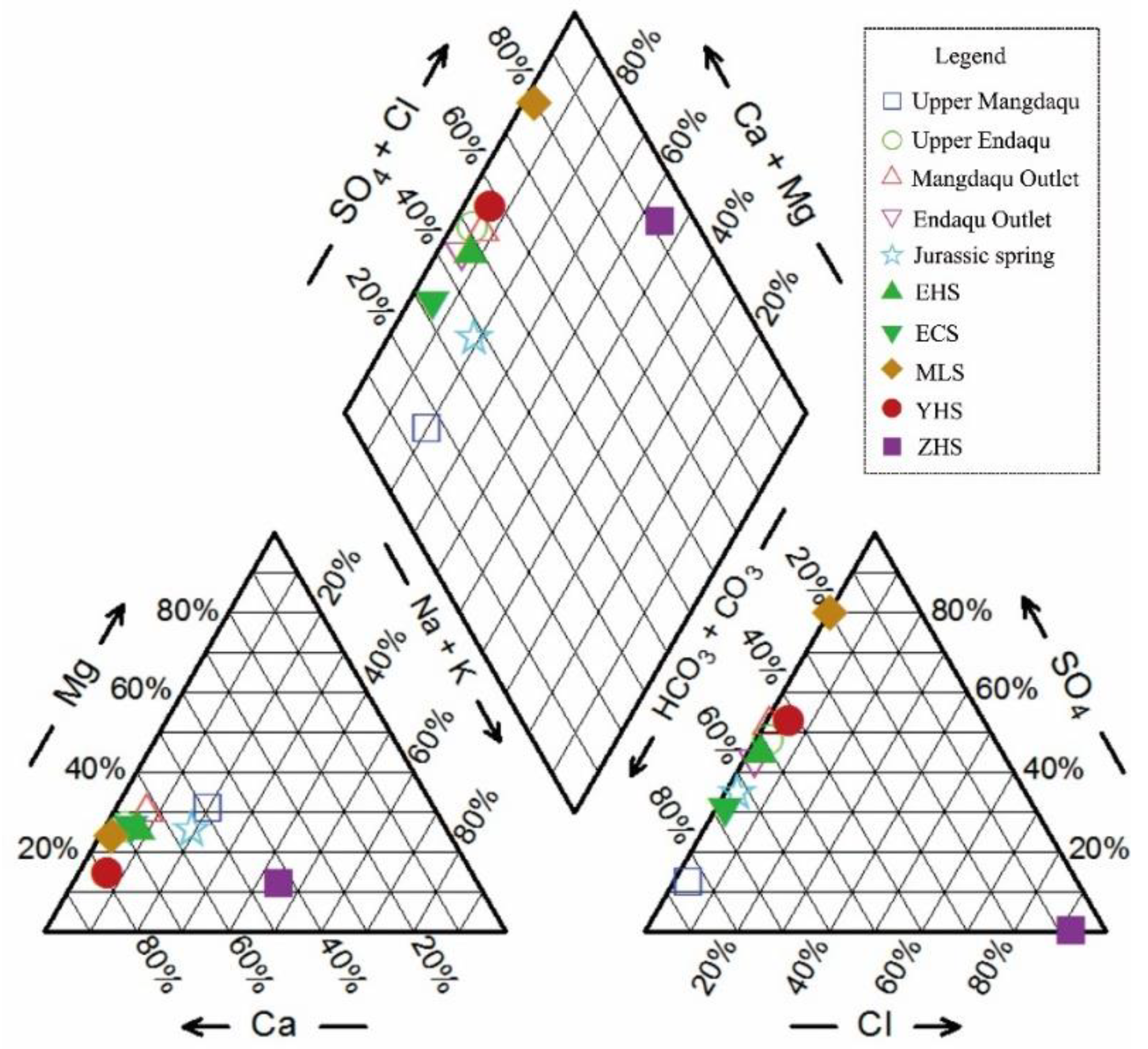
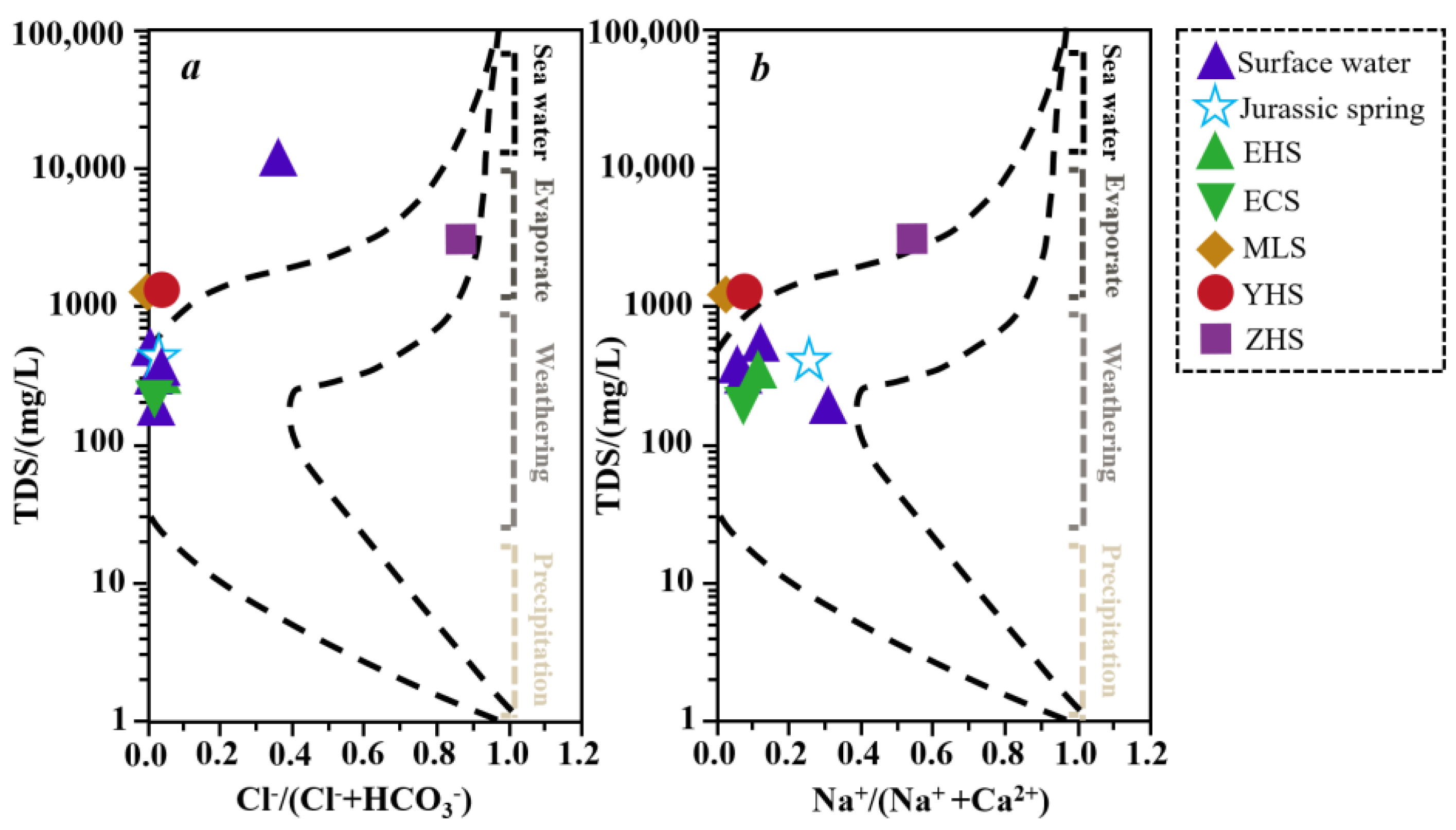
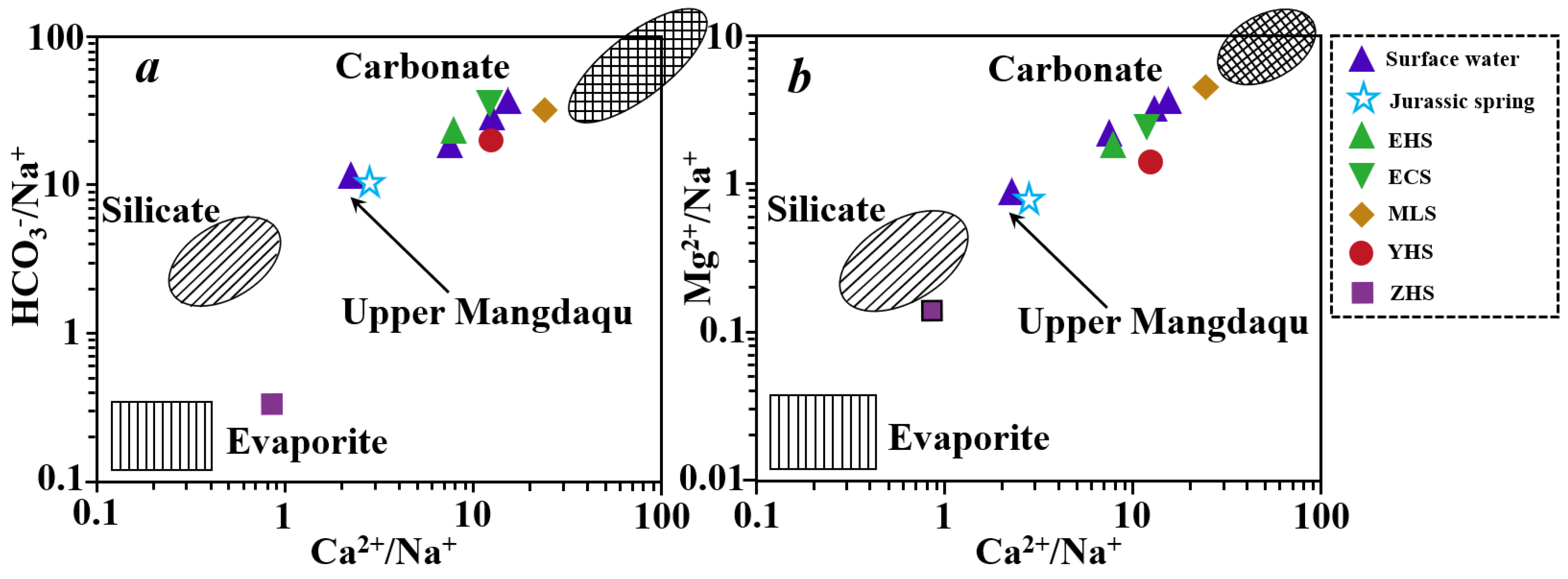
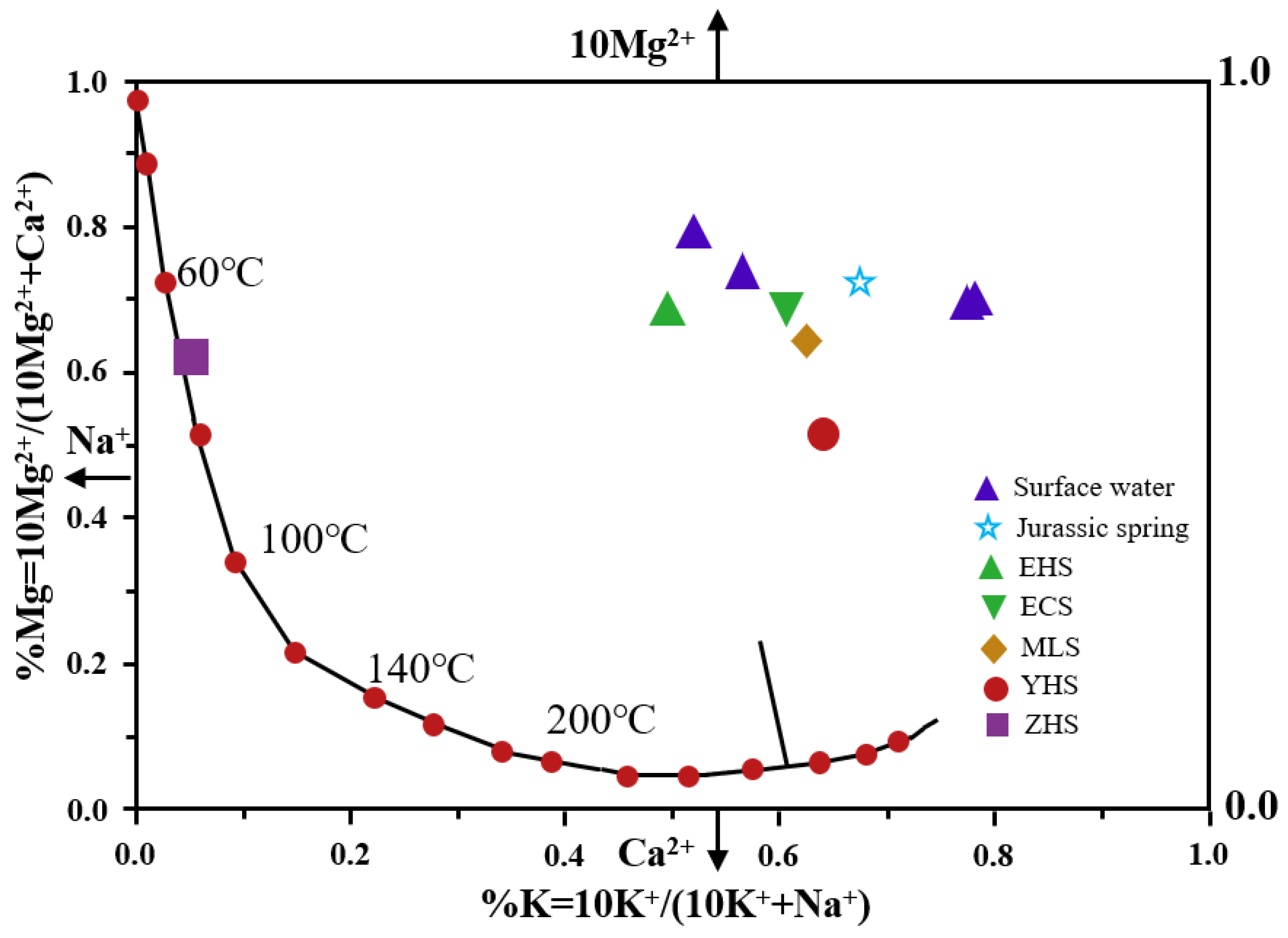
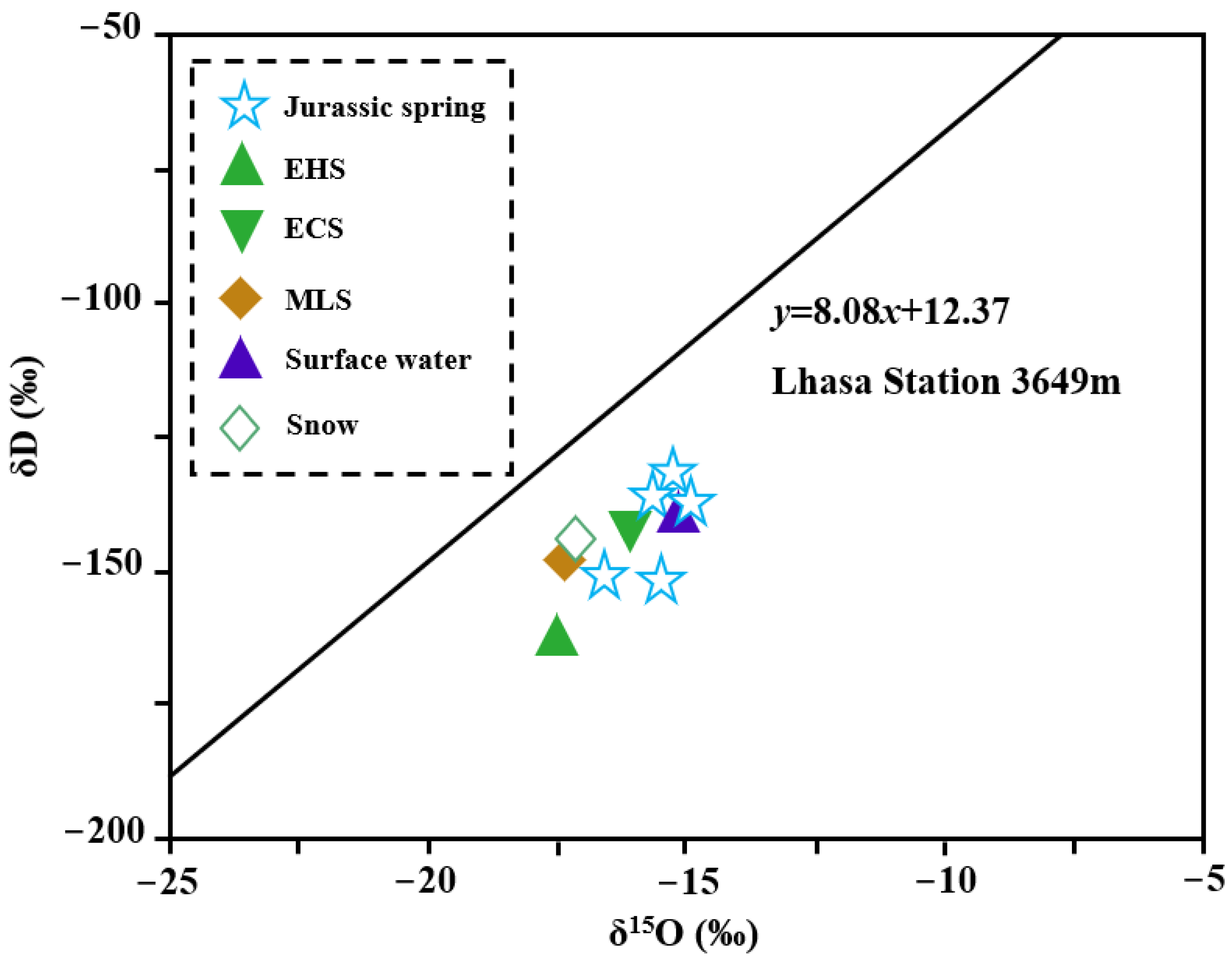
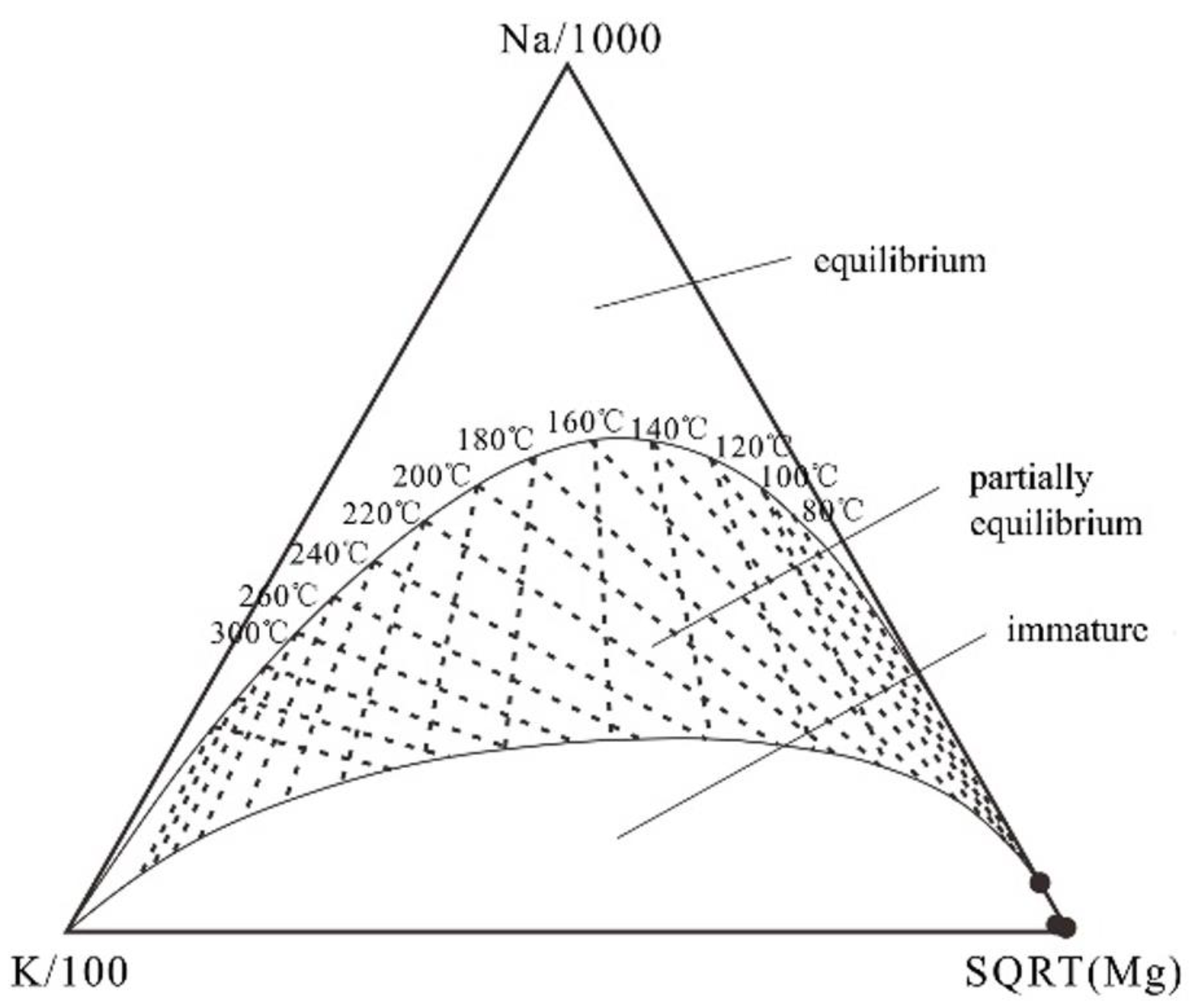

| Exposed Stratum | Flow (L/s) | Elevation (m) | Coordinate (°) | ||
|---|---|---|---|---|---|
| Latitude | Longitude | ||||
| Q1 | J3x | 0.1 | 3421.0 | 31.39404732 | 96.87404919 |
| Q3 | J3x | 0.2 | 3683.4 | 31.52550351 | 96.78638578 |
| Q4 | J3x | 0.4 | 3641.8 | 31.39326667 | 96.85236389 |
| Q6 | J3x | 0.3 | 3554.8 | 31.49029722 | 96.80910278 |
| Q14 | J3x | 0.5 | 4073.6 | 31.22312778 | 96.93929444 |
| EHS | T3b | 50.0 | 3668.0 | 31.45893541 | 96.73557212 |
| ECS | T3b | 180.0 | 3670.0 | 31.46821501 | 96.73596142 |
| MLS | T3b | 10.0 | 4034.0 | 31.50596799 | 96.95658855 |
| Angqu river (Mangda Bridge) | / | / | 3465.0 | 31.51475212 | 96.80958127 |
| Snow water | / | / | 4034.0 | 31.22569246 | 96.94655959 |
| Statistical Data | Measured Discharge (m3/s) | Temperature (°C) | pH | Conductivity (μs/cm) | Arsenic Concentration (μg/L) | |
|---|---|---|---|---|---|---|
| EHS (n = 11) | Range | 0.039~0.06 | 18.9~30.4 | 7.32~8.05 | 425~533 | 344.6~642.1 |
| ± SD | 0.050 ± 0.0072 | 23.56 ± 3.87 | 7.56 ± 0.26 | 470 ± 35 | 483.0 ± 88.3 | |
| ECS (n = 11) | Range | 0.109~0.28 | 10.8~15 | 7.36~8.45 | 248~540 | 104.5~271.2 |
| ± SD | 0.184 ± 0.062 | 13.6 ± 1.2 | 7.87 ± 0.37 | 405 ± 92 | 179.9 ± 50.6 | |
| MLS (n = 11) | Range | 0.002~0.018 | 25.3~32.4 | 6.44~7.26 | 542~2287 | 1139.4~1933.0 |
| ± SD | 0.010 ± 0.006 | 30.3 ± 2.5 | 6.8 ± 0.2 | 1787 ± 458 | 1433.0 ± 270.0 | |
| MRS (n = 11) | Range | 0~0.012 | 17.5 (n = 1) | 7.01~7.87 | 1577~1802 | 373.6~563.9 |
| ± SD | 0.011 ± 0.002 | 17.5 (n = 1) | 7.4 ± 0.61 | 1690 ± 159 | 468.8 ± 0.134.6 | |
| Jurassic Springs (n = 5) | Range | 0.0001~0.0005 | 1.4~2.5 | 7.88~8.36 | 364~561 | 0.2~28.9 |
| ± SD | 0.0003 ± 0.0002 | 1.9 ± 0.4 | 8.14 ± 0.20 | 454 ± 75 | 8.5 ± 13.7 | |
| Total hot springs (n = 44) | Range | 0~0.28 | 10.8~32.4 | 6.44~8.45 | 248~2287 | 104.5~1933.0 |
| ± SD | 0.077 ± 0.08 | 22.3 ± 0.54 | 7.41 ± 0.54 | 933 ± 703 | 685.5 ± 551.9 |
| Index | Temperature | pH | ORP | Conductivity | As | K+ | Na+ | Ca2+ | Mg2+ | HCO3− | F− | Cl− | SO42− |
|---|---|---|---|---|---|---|---|---|---|---|---|---|---|
| temperature | 1 | −0.92 ** | −0.77 ** | 0.75 * | 0.77 ** | 0.90 ** | 0.31 | 0.79 ** | 0.48 | 0.64 * | 0.90 ** | 0.46 | 0.44 |
| pH | 1 | 0.59 | −0.58 | −0.62 | −0.85 ** | −0.34 | −0.72 * | −0.23 | −0.74 * | −0.82 ** | −0.22 | −0.57 | |
| ORP | 1 | −0.88 ** | −0.77 ** | −0.88 ** | −0.25 | −0.77 ** | −0.71 * | −0.39 | −0.91 ** | −0.70 * | −0.20 | ||
| conductivity | 1 | 0.92 ** | 0.84 ** | 0.18 | 0.83 ** | 0.90 ** | 0.18 | 0.90 ** | 0.89 ** | 0.16 | |||
| As | 1 | 0.80 ** | −0.05 | 0.88 ** | 0.78 ** | 0.16 | 0.86 ** | 0.78 ** | 0.38 | ||||
| K+ | 1 | 0.38 | 0.93 ** | 0.53 | 0.66 * | 0.99 ** | 0.51 | 0.54 | |||||
| Na+ | 1 | 0.24 | 0.002 | 0.64 * | 0.26 | −0.05 | 0.15 | ||||||
| Ca2+ | 1 | 0.54 | 0.52 | 0.92 ** | 0.53 | 0.67 * | |||||||
| Mg2+ | 1 | −0.23 | 0.62 | 1.00 ** | −0.23 | ||||||||
| HCO3− | 1 | 0.55 | −0.26 | 0.68 * | |||||||||
| F− | 1 | 0.61 | 0.46 | ||||||||||
| Cl− | 1 | −0.24 | |||||||||||
| SO42− | 1 | ||||||||||||
| SiO2 |
| Equation (1) | Equation (2) | |||
|---|---|---|---|---|
| Storage Temperature (°C) | Circulation Depth (m) | Storage Temperature (°C) | Circulation Depth (m) | |
| EHS | 45.37 | 1074 | 12.76 | 141.59 |
| ECS | 39.93 | 918 | 7.21 | −16.92 |
| MLS | 63.68 | 1596 | 31.61 | 680.36 |
| YHS | 82.60 | 2137 | 51.43 | 1246.51 |
| ZHS | 52.32 | 1272 | 19.88 | 345.15 |
| Temperature(°C) | Enthalpy (×4.1868 J/g) | SiO2 Content (mg/L) | Temperature (°C) | Enthalpy (×4.1868 J/g) | SiO2 Content (mg/L) |
|---|---|---|---|---|---|
| 50 | 50.0 | 13.5 | 200 | 203.6 | 265 |
| 75 | 75.0 | 26.6 | 225 | 230.9 | 365 |
| 100 | 100.1 | 48 | 250 | 259.2 | 486 |
| 125 | 125.4 | 80 | 275 | 289.0 | 614 |
| 150 | 151.0 | 125 | 300 | 321.0 | 692 |
| 175 | 177.0 | 185 |
| EHS | ECS | MLS | YHS | |
|---|---|---|---|---|
| Y1 (%) | 89 | 68 | 62 | 62 |
| Y2 (%) | 11 | 32 | 38 | 38 |
| C (μg/L) | 642.10 | 271.20 | 1832.40 | 643.50 |
| Ch (μg/L) | 5602.64 | 785.88 | 4774.79 | 1646.11 |
| Flow Q (m3/s) | 0.050 | 0.109 | 0.002 | / |
| Cold water arsenic flux (mg/s) | 0.487 | 0.382 | 0.0083 | / |
| Hot water arsenic flux (mg/s) | 30.814 | 27.411 | 3.628 | / |
| Proportion of cold water arsenic flux in total arsenic flux (%) | 1.56% | 1.38% | 0.23% | / |
| Proportion of hot water arsenic flux in total arsenic flux (%) | 98.44% | 98.62% | 99.77% | / |
Disclaimer/Publisher’s Note: The statements, opinions and data contained in all publications are solely those of the individual author(s) and contributor(s) and not of MDPI and/or the editor(s). MDPI and/or the editor(s) disclaim responsibility for any injury to people or property resulting from any ideas, methods, instructions or products referred to in the content. |
© 2023 by the authors. Licensee MDPI, Basel, Switzerland. This article is an open access article distributed under the terms and conditions of the Creative Commons Attribution (CC BY) license (https://creativecommons.org/licenses/by/4.0/).
Share and Cite
Zhang, Z.; Zhou, L.; He, Y.; Luo, Z.; Chen, S. Characteristics and Source Analysis of High-Arsenic Groundwater in Typical Watershed Areas of Tibet, China. Water 2023, 15, 533. https://doi.org/10.3390/w15030533
Zhang Z, Zhou L, He Y, Luo Z, Chen S. Characteristics and Source Analysis of High-Arsenic Groundwater in Typical Watershed Areas of Tibet, China. Water. 2023; 15(3):533. https://doi.org/10.3390/w15030533
Chicago/Turabian StyleZhang, Zhongwei, Liangjing Zhou, Yunjiao He, Zhaohui Luo, and Sibao Chen. 2023. "Characteristics and Source Analysis of High-Arsenic Groundwater in Typical Watershed Areas of Tibet, China" Water 15, no. 3: 533. https://doi.org/10.3390/w15030533
APA StyleZhang, Z., Zhou, L., He, Y., Luo, Z., & Chen, S. (2023). Characteristics and Source Analysis of High-Arsenic Groundwater in Typical Watershed Areas of Tibet, China. Water, 15(3), 533. https://doi.org/10.3390/w15030533





